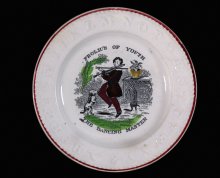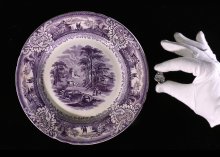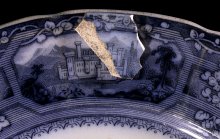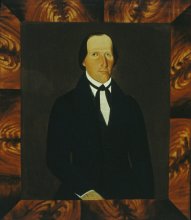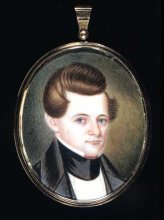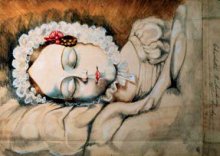Early Statehood (1818-1848)
On December 3, 1818, Illinois became the twenty-first state of the Union. Ostensibly a free state, slavery was “grandfathered” in to the constitution for existing colonial slaveholders, and all citizens were permitted to keep indentured servants. Over the next thirty years, the state experienced a transition from an American frontier to a settled and rapidly developing agricultural state. Technology changed agriculture and expanded markets. It also fostered changes in government, legal, and educational institutions.
In 1832, Black Sparrow Hawk, a Sauk warrior, and more than 1,000 Sauk and Fox, attempted to return to their principal community of Saukenuk, present-day Rock Island. Conflict soon followed, and warriors fought a series of battles with Federal troops and Illinois militia in Illinois and Wisconsin. Decimated in a final fight at Bad Axe in Wisconsin, the Sauk and Fox, along with other tribes once resident in Illinois, signed a treaty reaffirming their land cessions and moved to reservations west of the Mississippi River.
The scene in this child’s plate may have been hand colored by a child of less than 10 years old. Children typically started working at the potteries in Staffordshire, England, by the age eight, but some started as young as five or six years old.
This plate fragment came from the home site of Alexander Clark, an African American blacksmith living in New Philadelphia, Illinois, in the mid-1800s. It shows a portion of a bridge and person bridling a horse, an image that can also be found near the center of a transfer print plate with the image “Rural Scenery.”
Rarely are completely intact artifacts found during archaeological explorations. It is up to archaeologists and anthropologists to use their knowledge and skill to find the missing pieces in order to tell the rest of the story. This plate fragment was recovered from excavations at New Philadelphia, an African American settlement in western Illinois founded by Free Frank McWhorter, a former slave.
Sheldon Peck moved from upstate New York to Babcock's Grove (present day Lombard, Illinois) in 1837, living with his wife, Harriet, in a covered wagon while he built his farm house. He farmed and raised sheep while also traveling the Illinois countryside painting portraits. Peck was a self-taught artist. His portraits follow many of the conventions of the 19th century, with broad flat areas of color and a stiff and starched formality. Peck would paint his sitter’s face in person and then finish the clothing and backgrounds at his home.
This very fine miniature portrait is an example of a personal keepsake that could be carried or worn as jewelry as a memento of a friend or loved one in the days prior to photography. The artist, Philip Jenkins, was living in Kentucky at the time this portrait was thought to have been painted. The sitter, Isaac Dutcher, had recently moved to Quincy, Illinois, in 1838 from New York.
Today in the United States, many people feel very uncomfortable looking at a death portrait. However, in earlier times, it was an accepted means of remembering and memorializing someone who had died. In the 19th century, many families lost children to accident and disease.
Chief Aptakisic, or Half Day, presented this ceremonial war club to Stephen F. Gale, an early settler, before leaving Chicago with a band of Potawatomi Indians for a reservation in Iowa.
In the 1800s and early 1900s, before federal protections for all birds were established, egg collecting thrived as a hobby. Collectors bought, sold, and traded eggs with one another. In 1918, the Migratory Bird Treaty Act was established to stop the commercialization of birds, primarily because market hunting for restaurants and to provide feathers for the hat trade was decimating populations. As egg collecting slowly disappeared in the years following, many collectors gave their collections to museums.
The Prairie Cicada’s (Megatibicen dorsatus) sound is unique to the tallgrass prairie. Because much of the prairie was converted to farming and other uses before it could be thoroughly studied, we may never know what the cacophony of insect songs sounded like in this distinctive habitat. Many of those insects are now as rare as original prairie remnants. The Prairie Cicada persists in some of those remnants as well as in small railroad prairies.
Two years after Abraham Lincoln’s father, Thomas Lincoln, moved his family to the Little Pigeon Creek settlement in Southern Indiana, the family faced tragedy. Abraham was just nine years old when his mother, Nancy Hanks Lincoln, became gravely ill. Just two weeks later, on October 5, 1818, he lost his mother to “Milk Sickness.”
Pages






